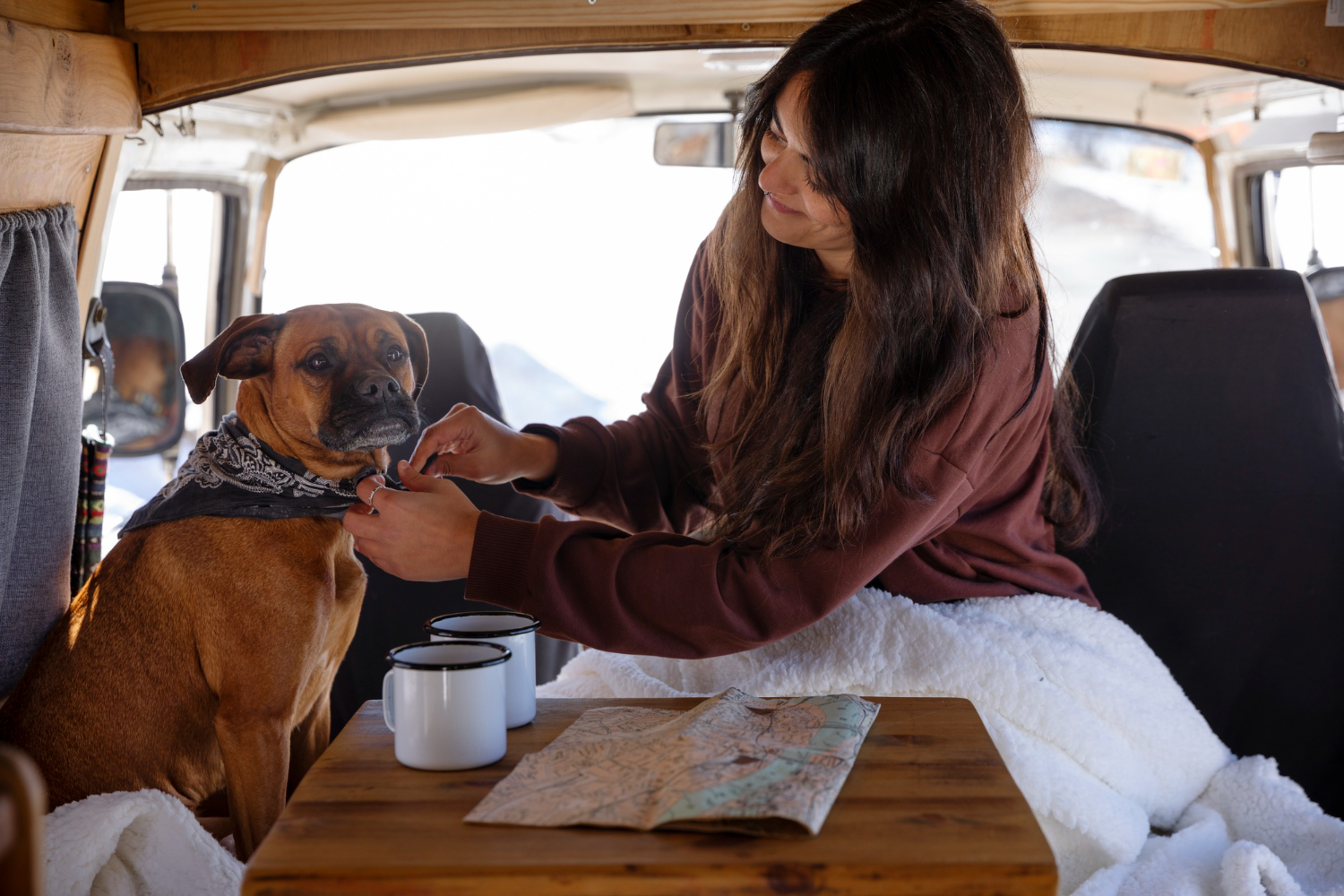Have you decided to go on a van trip with your faithful four-legged companions? It is an excellent idea ! Traveling with pets can be a wonderful experience, but it still requires some preparation and precautions to ensure the well-being of your furry friends.
Vehicle preparation
The first essential step when traveling in a van with animals is to prepare the vehicle to ensure their comfort and safety. Make sure your van has suitable space to accommodate your pets. Choose a layout with baskets or cages, securely fixed, to avoid sudden movements during journeys. Also provide mats or cushions so that they can rest comfortably.
Car safety
Car safety is essential to ensure the protection of your animals during the journey. Make sure they are properly secured, whether using a special animal belt or a suitable carrier. Avoid leaving them loose in the van, as this can be dangerous in the event of sudden braking or an accident. Remember to take frequent breaks to allow them to stretch their legs and drink water.
Document preparation
Before you leave on your trip, make sure you have all the necessary documents for your pets. They must be identified by an electronic chip and have a European passport if you travel abroad. Also make sure you are up to date on vaccinations and anti-parasitic treatments. Take the time to check whether your travel destination has any special restrictions on pets and find out what the rules are.
health and wellbeing
The well-being of your animals is a priority when traveling by van. Make sure they have a balanced and sufficient diet, adapted to their species and age. Don’t forget to bring them fresh water regularly and take breaks to let them stretch their legs. If your pet has specific health problems, do not hesitate to consult your veterinarian before leaving.
Activities and exercise
Traveling in a van gives you the opportunity to explore new places with your pets, so take advantage of this to offer them new experiences and activities. Find out where you can walk them safely, as well as activities appropriate for their species. For example, if you have a dog, you can plan hikes or agility games. If you have a cat, set up a secure space inside the van so they can relax and observe the scenery.
Respect for other travelers
When traveling in a van with your pets, it is important to respect other travelers. Make sure that your animals do not disturb other people at rest areas or campsites. Keep your dogs on a leash and pick up their droppings. Also respect the rules of cleanliness and hygiene, ensuring that your animals are clean and do not leave hair or unpleasant odors in the van.

Socializing while traveling: creating unforgettable memories with other travelers and their pets
Traveling in a van with your pets is not only a personal adventure, but it is also a unique opportunity to meet and socialize with other animal lovers on the road. Van travel has grown in popularity in recent years, meaning the chances of bumping into other travelers with their four-legged companions are high.
Meeting other animals can be beneficial for your pet. This can enrich their environment, help them develop new social skills and even allow them to make new friends. However, it is crucial to ensure that these encounters take place in the best possible conditions to guarantee the safety and well-being of all animals involved.
Choosing the Right Time and Place
When you find yourself in a new place, it is essential to identify a suitable space for your pets to get acquainted with their new friends. Dog beaches, parks or campgrounds specifically designed for travelers with pets can be great options. It is important to ensure that the space is secure and appropriate for the species and size of your pet.
Let the animals take the lead
When first meeting animals, it is best to let them get acquainted at their own pace. Some animals may be shy or fearful, while others may be more bold. Observe their body language and be prepared to intervene if necessary.
Practical advice
Equip your pet with a clearly readable tag with your telephone number in case of unexpected separation. It’s also helpful to have a recent photo of your pet on your phone, in case you need to ask for help finding them.
Before you travel, find out about pet travel groups and communities in the area you plan to visit. These groups can be a great resource for getting recommendations on places to visit, sharing practical tips, or even setting up meetups.
Choose the right places for your companion
When we travel in a van with our pets, it’s not just about enjoying the journey, but also about making sure that the destinations are as pleasant for them as they are for us. The environment can greatly influence your pet’s well-being, so it is essential to choose destinations that are suitable for them.
Finding pet-friendly destinations
One of the fundamental aspects of traveling with an animal is ensuring that the destination is animal-friendly. This means looking for places that not only accept animals, but also welcome them warmly. Some places offer specific facilities for pets, like dog parks, dedicated beaches, or even pet-friendly cafes.
For dogs, for example, many cities now have dog parks where dogs can run freely and socialize with other dogs. If you are traveling with a cat, look for peaceful places, away from noise and hustle and bustle, where they can calmly observe their surroundings.
Your pet’s specific needs
Each animal is unique. Some like adventure and discovery, while others prefer calm and routine. It is crucial to understand your pet’s needs and preferences before deciding on your destination. If your dog loves to swim, for example, look for lakes or beaches. If your cat is curious, perhaps a place with lots of window viewing would be ideal.
Climatic considerations
Just like us, animals can be sensitive to climatic variations. If you plan to travel to a very hot destination, make sure your pet will be comfortable and have enough shade and water. Conversely, for colder destinations, think about how you will keep your pet warm, especially at night.













